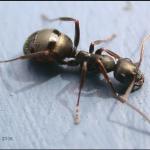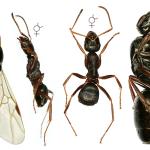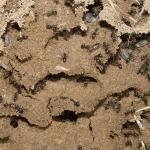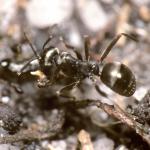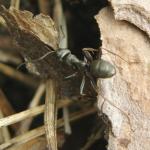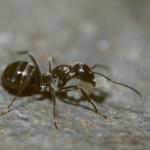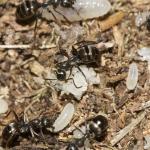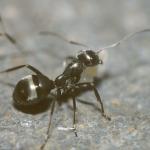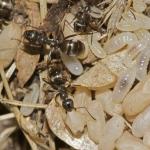Formica fusca is a dark-bodied species, 4-7 mm long, common and widely distributed on uncultivated land. This species is very similar to Formica lemani. Taxonomic and behavioural differences are given in the F. lemani profile.
Editor's note. The original profile combined the two species F. fusca and F. lemani but this has been split by the editor to follow the Atlas style.
Formica fusca is common throughout the South Midlands and lowland Britain but has a much more localised distribution in northern England, Ireland and Scotland. There is a somewhat anomalous population at Rannoch, Mid Perth where confirmed specimens were taken by Donisthorpe in 1912 and in more recent years by J Pontin & S Hoy. Flourishing colonies were present on lower slopes of rough grazed meadow in 1996. Other populations are known from Tiree, Eigg and other south western islands and on mainland Kintyre, South Galloway and very locally on sheltered banks as far north as Torridon (Collingwood 1961). The species also occurs in the Channel Islands, the Isles of Scilly, Lundy and the Isle of Man.
Not listed in Shirt (1987) or by Falk (1991). There is no noticeable decline in this species which continues to flourish in all its known habitats.
Nests are sited in open woodland, woodland verges, heaths and moorland.
Winged queens and males appear in July and August. Individuals disperse from the parent nest sporadically and mating occurs on the ground. New nests are started by individual queens.
They nest under stones and in tree stumps under loose bark. F. fusca occasionally builds earth nests anf they also nest in turfy banks. F. fusca has single nests usually with single queens. Individual established nests may have up to a thousand workers.
Workers forage individually. They are predators on other insects. They also seek out aphid honey dew. F. fusca is often to be seen ascending trees - but individually, not in close columns.
This species is subject to raiding by Formica sanguinea in localities where that species occurs. No commensal ant species are known but beetles of the genera Atemeles, Zyras and a few others are occasionally present. F. fusca are known to accept F. exsecta queens in Britain. Mixed nests of F. rufa queens, very small workers and a number of host F fusca workers are occasionally recorded.
2005


